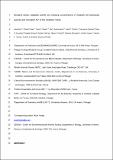Oxidative stress, metabolic activity and mercury concentrations in Antarctic krill Euphausia superba and myctophid fish of the Southern Ocean
Abstract
Indicators of oxidative stress and metabolic capacity are key factors in understanding the fitness of wild populations. In the present study, these factors were evaluated in the pelagic Southern Ocean taxa Antarctic krill (Euphausia superba) and myctophid fish (Electrona antarctica, Gymnoscopelus braueri and G. nicholsi) to establish a baseline record for future studies. Mercury (Hg) concentrations were also analysed to evaluate its potential impacts on species biochemical performance. E. superba had higher metabolic activity than most of the myctophid species, which may explain the comparatively lower energy reserves found in the former. The activity of antioxidant enzymes showed, generally, a lower level in E. superba than in the myctophid species. The lack of any relationship between Hg concentrations and organisms' antioxidant and biotransformation defence mechanisms indicate that levels of Hg accumulated in the studied species were not high enough to affect their biochemical processes adversely.
Citation
Seco , J , Freitas , R , Xavier , J C , Bustamante , P , Coelho , J P , Coppola , F , Saunders , R A , Almeida , Â , Fielding , S , Pardal , M A , Stowasser , G , Pompeo , G , Tarling , G A , Brierley , A S & Pereira , E 2021 , ' Oxidative stress, metabolic activity and mercury concentrations in Antarctic krill Euphausia superba and myctophid fish of the Southern Ocean ' , Marine Pollution Bulletin , vol. 166 , 112178 . https://doi.org/10.1016/j.marpolbul.2021.112178
Publication
Marine Pollution Bulletin
Status
Peer reviewed
ISSN
0025-326XType
Journal article
Description
Authors acknowledge the financial support of the Portuguese Foundation for the Science and Technology (FCT) through PhD grants to José Seco (SRFH/PD/BD/113487), Francesca Coppola (SFRH/BD/118582/2016) and Ângela Almeida (SFRH/BD/110218/2015), and the Portuguese Polar Program PROPOLAR. This study also benefited from the strategic program of MARE (Marine and Environmental Sciences Centre) financed by FCT (UIDB/04292/2020). João Pedro Coelho was funded by the Integrated Program of SR&TD ‘Smart Valorization of Endogenous Marine Biological Resources Under a Changing Climate’ (Centro-01-0145-FEDER-000018), co-funded by Centro 2020 program, Portugal 2020 and the European Regional Development Fund. Thanks are due for the financial support to CESAM (UIDB/50017/2020+UIDP/50017/2020) and REQUIMTE (UIDB/50006/2020). The Institut Universitaire de France (IUF) is acknowledged for its support to P. Bustamante as a Senior Member. RAS, SF, GS and GT were supported by the British Antarctic Surveys Ecosystem Programme, which is part of NERC and UKRI.Collections
Items in the St Andrews Research Repository are protected by copyright, with all rights reserved, unless otherwise indicated.

